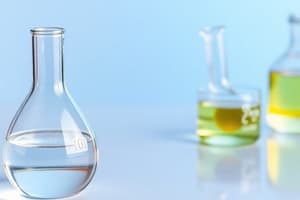Podcast
Questions and Answers
What is the role of enthalpy in chemical reactions?
What is the role of enthalpy in chemical reactions?
- To describe the heat absorbed or released during a reaction (correct)
- To determine the speed of the reaction
- To balance the chemical equation
- To measure the disorder of the system
In an endothermic reaction, the products have lower energy than the reactants.
In an endothermic reaction, the products have lower energy than the reactants.
False (B)
In an exothermic reaction, what happens to the energy?
In an exothermic reaction, what happens to the energy?
- Energy is released to the surroundings. (correct)
- Energy is converted into mass.
- Energy remains constant.
- Energy is absorbed from the surroundings.
A reaction with a positive change in enthalpy ($\Delta H > 0$) is called a(n) ___________ reaction.
A reaction with a positive change in enthalpy ($\Delta H > 0$) is called a(n) ___________ reaction.
Which of the following is true for an exothermic reaction?
Which of the following is true for an exothermic reaction?
Define enthalpy change and explain how it indicates whether a reaction is endothermic or exothermic.
Define enthalpy change and explain how it indicates whether a reaction is endothermic or exothermic.
Hess's Law states that the enthalpy change of a reaction depends on the path taken from reactants to products.
Hess's Law states that the enthalpy change of a reaction depends on the path taken from reactants to products.
According to Hess's Law, if a reaction is reversed, what happens to the sign of $\Delta H$?
According to Hess's Law, if a reaction is reversed, what happens to the sign of $\Delta H$?
What does Hess's Law allow us to calculate?
What does Hess's Law allow us to calculate?
Hess's Law is based on the principle that enthalpy is a ______ function.
Hess's Law is based on the principle that enthalpy is a ______ function.
Explain how Hess's Law can be used to determine the enthalpy change for a reaction that cannot be measured directly.
Explain how Hess's Law can be used to determine the enthalpy change for a reaction that cannot be measured directly.
Match the following terms with their correct descriptions:
Match the following terms with their correct descriptions:
Consider the following reactions:
A → B, $\Delta H_1 = -50 kJ$
B → C, $\Delta H_2 = +20 kJ$
Using Hess's law, what is the enthalpy change for the reaction A → C?
Consider the following reactions:
A → B, $\Delta H_1 = -50 kJ$
B → C, $\Delta H_2 = +20 kJ$
Using Hess's law, what is the enthalpy change for the reaction A → C?
A negative enthalpy change indicates that the reaction is endothermic.
A negative enthalpy change indicates that the reaction is endothermic.
In which of the following scenarios would Hess’s Law be most useful?
In which of the following scenarios would Hess’s Law be most useful?
How does enthalpy help in predicting the feasibility of a chemical reaction?
How does enthalpy help in predicting the feasibility of a chemical reaction?
According to Hess's Law, the total enthalpy change for a chemical reaction is the sum of the enthalpy changes for each step, regardless of whether the reaction is carried out in one step or in multiple ______.
According to Hess's Law, the total enthalpy change for a chemical reaction is the sum of the enthalpy changes for each step, regardless of whether the reaction is carried out in one step or in multiple ______.
Given the following reactions:
N2(g) + O2(g) → 2NO(g) $\Delta H = +180 kJ
2NO(g) + O2(g) → 2NO2(g) $\Delta H = -112 kJ
Calculate the enthalpy change for the reaction:
N2(g) + 2O2(g) → 2NO2(g)
Given the following reactions:
N2(g) + O2(g) → 2NO(g) $\Delta H = +180 kJ
2NO(g) + O2(g) → 2NO2(g) $\Delta H = -112 kJ
Calculate the enthalpy change for the reaction:
N2(g) + 2O2(g) → 2NO2(g)
The enthalpy change for an exothermic reaction is always positive.
The enthalpy change for an exothermic reaction is always positive.
Which of the following processes is endothermic?
Which of the following processes is endothermic?
Explain the difference between enthalpy and internal energy.
Explain the difference between enthalpy and internal energy.
In calorimetry, the heat absorbed or released by a reaction is measured using a(n) ______.
In calorimetry, the heat absorbed or released by a reaction is measured using a(n) ______.
Which of the following factors does not affect the enthalpy change of a reaction?
Which of the following factors does not affect the enthalpy change of a reaction?
If the enthalpy change ($\Delta H$) is negative for a reaction, it indicates that the reaction requires energy input to proceed.
If the enthalpy change ($\Delta H$) is negative for a reaction, it indicates that the reaction requires energy input to proceed.
Match each term with its appropriate description.
Match each term with its appropriate description.
Explain how you would determine the enthalpy change for the reaction: $2H_2(g) + O_2(g) → 2H_2O(g)$ using the following information:
$2H_2(g) + O_2(g) → 2H_2O(l)$ $\Delta H = -571.6 kJ$
$2H_2O(l) → 2H_2O(g)$ $\Delta H = +88.0 kJ$
Explain how you would determine the enthalpy change for the reaction: $2H_2(g) + O_2(g) → 2H_2O(g)$ using the following information: $2H_2(g) + O_2(g) → 2H_2O(l)$ $\Delta H = -571.6 kJ$ $2H_2O(l) → 2H_2O(g)$ $\Delta H = +88.0 kJ$
The standard enthalpy of ______ is the change in enthalpy when one mole of a substance is formed from its elements in their standard states.
The standard enthalpy of ______ is the change in enthalpy when one mole of a substance is formed from its elements in their standard states.
Which of the following is true regarding the calculation based on Hess's Law of the reaction: $2H_2(g) + O_2(g) → 2H_2O(g)$ based on the two reactions:
$2H_2(g) + O_2(g) → 2H_2O(l)$ $\Delta H = -571.6 kJ$
$2H_2O(l) → 2H_2O(g)$ $\Delta H = +88.0 kJ$
Which of the following is true regarding the calculation based on Hess's Law of the reaction: $2H_2(g) + O_2(g) → 2H_2O(g)$ based on the two reactions:
$2H_2(g) + O_2(g) → 2H_2O(l)$ $\Delta H = -571.6 kJ$ $2H_2O(l) → 2H_2O(g)$ $\Delta H = +88.0 kJ$
Enthalpy change is a path-dependent function, meaning that its value depends on the specific steps taken during a reaction
Enthalpy change is a path-dependent function, meaning that its value depends on the specific steps taken during a reaction
Flashcards
Thermochemistry
Thermochemistry
The study of energy changes (heat) in chemical reactions.
Enthalpy (H)
Enthalpy (H)
The heat content of a system at constant pressure.
Endothermic Process
Endothermic Process
A process that absorbs energy from its surroundings; ΔH is positive.
Exothermic Process
Exothermic Process
Signup and view all the flashcards
Enthalpy Change (ΔH)
Enthalpy Change (ΔH)
Signup and view all the flashcards
Hess's Law
Hess's Law
Signup and view all the flashcards
Steps to solving Hess' law
Steps to solving Hess' law
Signup and view all the flashcards
Study Notes
- General Chemistry II involves understanding concepts like enthalpy and Hess's Law.
Learning Points:
- Enthalpy's role in chemical reactions should be described.
- The change in enthalpy for a given reaction can be calculated using Hess's Law.
- Awareness toward making informed decisions to promote energy efficiency and sustainability should be developed.
Enthalpy Change:
- Endothermic reactions result in products with more energy.
- Represented as ΔH (+).
- Exothermic reactions release energy, leading to products with lower energy than reactants.
- Represented as ΔH (-).
- Enthalpy is helpful for predicting the feasibility of a chemical reaction
Hess’s Law:
- The enthalpy change of an overall process is the sum of enthalpy changes of individual component steps.
Calculating ΔH for the formation of CO(g):
- Step 1 - Target: 2C(g)+ O2(g) → 2CO(g)
- Step 2 - Given equations:
- C(g) + O2(g) → CO2(g), ΔH = -393.5 kJ
- 2CO(g) + O2(g) → 2CO2(g), ΔH = -566.0 kJ
- Step 3 - Manipulation:
- (1) C(g) + O2(g) → CO2(g), ΔH = -393.5 kJ * 2 = 2C(g)+2O2(g) → 2CO2(g) , ∆H = -787 kJ
- (2) 2CO(g) + O2(g) → 2CO2(g), △H = -566.0 kJ becomes 2CO2(g) → 2CO(g) + O2(g), ∆H = +566.0 kJ
- Step 4 - Cancel common Species:
- 2C(g)+ O2(g) → 2CO(g) now contains 2C(g) + O2(g) → 2CO2(g) ∆H = -787 kJ and 2CO2(g) → 2CO(g) + O2(g) ∆H = + 566.0 kJ
- Resulting in: 2O2(g) - O2(g) = O2(g)
- 2C(g)+ O2(g) → 2CO(g)
- Step 5 - Compute:
- ΔH = -787 kJ + 566.0 kJ = -221 kJ
- 2C(g)+ O2(g) → 2CO(g) ΔH = -221 kJ
Exercise:
- 2H2(g) +O2(g) → 2H2O(g)
- 2H2(g)+ O2(g) → 2H2O(l) ΔH = -571.6 kJ
- 2H2O(l) → 2H2O(g) ΔH = +88.0 kJ
Studying That Suits You
Use AI to generate personalized quizzes and flashcards to suit your learning preferences.




